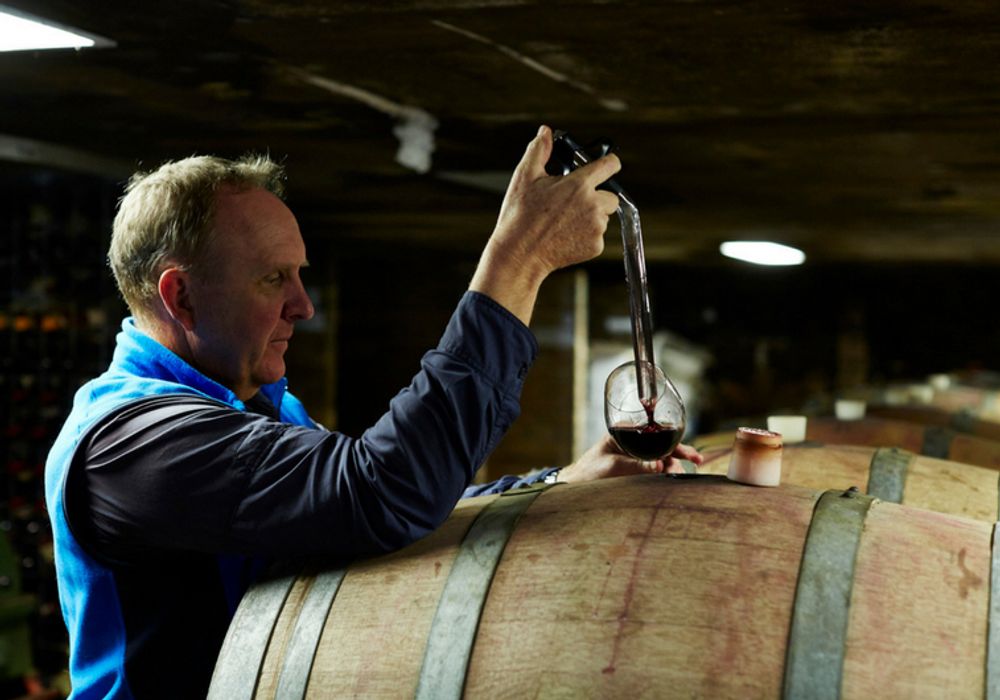“This growing diversity – regional, stylistic and philosophical – is, of course, why Australian wine today is such a different proposition from a few years ago,” writes Justin Keay.
This is an existential time for the world’s wine industry, with the fall in global trade, the ravages wrought by Covid 19, and the collapse in the on-trade in wealthy nations all having a major impact. Individual countries have had additional crosses to bear: Lebanon’s collapse into economic chaos, with the Lira losing 90% of its value in less than a year, is devastating a heavily import-dependent industry (everything from bottles, corks and labels upwards) whilst South Africa’s off/on alcohol sales and export bans has destroyed producer’s revenue stream there.
But what of Australia, such a long way from the fulcrum of the crises battering the world?
Despite localised lockdowns, the Lucky Country has had a ‘good pandemic’, whilst years of investment in an economy that until last year enjoyed over 20 years of unbroken GDP growth, has generally left its wine industry in buoyant health. Clever producers have consolidated market share at entry level (think Yellowtail and McGuigan) whilst higher-end winemakers have been eschewing oak for fresher and more expressive styles reflecting local conditions and soil. Defining itself by growing regionality and moving away from the French varieties that were once almost ubiquitous here, Australian wine is rightly getting more critical acclaim than ever before.
Yet 2020 was rough. With Australia arguably more impacted by climate change than any other country, producers have had to deal with drought, fire damage and smoke – Wine Australia reckons almost 5% of the national grape crop in 2019-20 was lost this way after the devastating bushfires – and now flood, with Hunter Valley just one of many regions finding itself underwater this month.
And despite the admirable low number of human casualties, Covid 19 has in fact impacted heavily, with restrictions and the absence of tourists hitting cellar door sales hard: last April the Australian Grape and Wine Authority said as many as 30% of the country’s 2600 wineries could go under.

February’s Cellar Door Fest is an important form of direct sales for Terre à Terre
And then there’s the impact of Australia’s grim diplomatic face-off with China, resulting from Canberra’s suggestion there should be a proper international investigation into the origins of the pandemic and its protests at China’s suppression of human rights in Hong Kong and amongst the Uighur Muslims. Beijing’s subsequent tariffs increase the price of a typical Australian bottle in China and Hong Kong by over 200% – potentially devastating given that China was the industry’s biggest export market, accounting for 37% of the total, or $800m. Big names like Penfolds are worst hit but all producers will be struggling to compensate even if they didn’t sell to China, as they fight off increased competition from those who did.
So as 2021 gets underway, what’s the mood? How do producers – particularly the smaller ones – see the future? And do they think international consumer perceptions of Australian wine are changing? I spoke to three premium family-run wineries in three different states to get an idea.
Moorooduc Estate in Victoria’s Mornington Peninsula
“Last year was very strange – the net effect of the pandemic was that my market-reach shrank – all the travel and work with the on-trade and our distributors dried up suddenly,” says Kate McIntyre MW at Moorooduc Estate in Victoria’s Mornington Peninsula, which has felt the impact of successive lockdowns in nearby Melbourne.
“During our most stringent lockdown, we were not allowed to travel more than 5 km from home but as wine was deemed an essential service, I could travel all around Melbourne,” she says.

Kate McIntyre MW online during her regular Tasting With Kate sessions
She has taken mitigating steps, including online tasting sessions every Thursday on You Tube, a Wine Club to sustain long term sales, and the establishment of closer relationships with restaurants and other outlets that sell Moorooduc wines.
“Doing online tastings is very rewarding even at painful times of the night. Likewise having to look presentable on Zoom (I am a morning person but wine just doesn’t taste as good at 4am). But I’ve been delighted to do them to keep in touch – and it’s really much easier than jet lag!” she admits.
McKintyre says 2020 made her realise once again the importance of personal relationships and building up and maintaining brand loyalty.
Regarding climate change she says Mornington Peninsula’s maritime location has been a mitigating factor but she has concerns about the long term viability of growing Chardonnay and especially Pinot Noir and has planted Shiraz and Nebbiolo to see how they perform.
“Bud burst is happening a month earlier than 10-15 years ago due to mild winters, whilst unsettled weather later in Spring can have a detrimental effect on flowering and fruit-set. This also means we are harvesting fruit in late February/early March, (rather than a month or 6 weeks later) when it is often still very hot, so cooling before processing is usually a necessity,” she says.
Terre à Terre in South Australia’s Adelaide Hills
Some 780 kilometers west, in Piccadilly Valley in Adelaide Hills, South Australia, Xavier Bizot of Terre à Terre and DAOSA says climate change hasn’t been such a worry for him, with three mild vintages in a row since 2019.
“The medium to long term impact of climate change could be felt in the first 20 years of the century, but in cool climate it tends to have a beneficial effect,” he says.

Xavier Bizot
Bizot never sold to China so hasn’t been hit directly by the new tariffs. He is upbeat, saying consumers are beginning to wake up to the new potential offered by Australian wine.
As you might expect from a Frenchman whose winery name translates as ‘Down to Earth’, Bizot says he is focused on terroir, having selected his vineyard sites based on their unique characters and their potential to produce fine wines. He is also adding new sites for sparkling wine production, very much a growth area.
“Australian wines have a lot more to offer than big oak and big alcohol. The UK consumer is looking for value and quality and starting to realise that Australia has a lot to offer,” he says, pointing to his Sauvignon Blanc and sparkling wines which he says will have a great vintage in 2021, whilst reds are maturing slowly and well.
Moss Wood in West Australia’s Margaret River
Almost 3000 kilometres further west, in Margaret River, West Australia, Keith Mugford, owner and winemaker at Moss Wood – the second winery in this region – is also pretty phlegmatic about climate change. A bigger worry has been the potential loss of sales because of the new Chinese tariffs.
“Despite being there since 2006, our sales have only been small, for all sorts of price and strategic reasons. Hong Kong is more frustrating. Our sales there go back to the 1980s. It’s been a good market for us and disappointing the future is now so uncertain,” he says, adding that he will “be happy to pick up the threads” if things improve.
He says the British market has been Moss Wood’s biggest and most reliable since exports started back in 1985.

Keith Mugford
“It seems British consumers enjoy our wines and we always try to be consistent with style and quality. I hope we can continue this and retain as many existing customers as possible but also promote effectively and introduce new customers to our individual vineyard wines,” he says, adding that Moss Wood is moving towards minimal intervention and further reducing environmental impact.
So is Australian wine changing?
Mugford says Moss Wood has never been a “big oak” producer but reckons there have been wider changes, with Chardonnay made in a leaner, finer style, which he reckons consumers appreciate. With reds generally, and Shiraz in particular, he thinks the picture is more nuanced.
“The popularity of ripe Shiraz continues and there are still “big” wines being made. There are, however, an interesting range of wines which display much more restraint and elegance. Given the range of climates in which it’s grown, this is hardly a surprise. The Barossa Valley celebrates its ability to produce generous, fully-ripened wines, expressing the rich end of the Shiraz spectrum, while southern Victoria makes in a more elegant, complex style.”
This growing diversity – regional, stylistic and philosophical – is, of course, why Australian wine today is such a different proposition from a few years ago. An industry once defined by brands and standardisation has become something much more sophisticated, which is why it will ride out its current challenges and continue to evolve.
Tasting 9 wines from these estates
Moorooduc Estate (Imported by Vindependents)
Why? Famed for great Pinots and Chardonnays, one of Mornington Peninsula’s best producers.
“Just delicious, food friendly wines that speak of cool maritime Australia translated with passion by the Moorooduc team – try them!” (McIntyre)
Moorooduc Estate Chardonnay 2017
Surprisingly rich for a cool climate Chardie, this comes from two of Moorooduc’s vineyards and undergoes wild yeast fermentation in French oak. Buttery, vanilla apple and soft citrus flavours, with wonderful length.
Moorooduc Robinson Vineyard Pinot Noir 2018 & Moorooduc McIntrye Pinot Noir 2018
Tasting these two single vineyard wines together shows just how well Moorooduc – and Mornington Peninsula – can interpret this famously tricky grape. The Robinson Vineyard apparently was once covered by an inland sea and this salinity is apparent in the wine, supported by lots of red and dark fruit and soft warm tannins. The McIntyre is a deserved classic, made from grapes grown on partially sandy soils, with minimal intervention and naturally fermented.
Terre à Terre and Daosa (Not yet imported)
Why? Known for its Bordeaux-style blends, Sauvignon Blanc and sparkling wines.
“We are aiming to produce classic Australian wines and remarkable sparkling wines, staying away from short-term trends.” (Bixot)
Daosa Natural Reserve (Piccadilly Valley)
This delicious sparkling wine, made with 83% Pinot Noir and 17% Chardonnay, sees lees ageing in old oak for 9 months and blending with older reserve wines before spending a further 18 months in bottle and undergoing natural fermentation. Dry and buttery on the palate, there is lots of fruit here and lots of character too. Not imported into the UK, but it should be.
Moss Wood (Imported by Jeroboams)
Why? One of Margaret River’s earliest and most iconic producers, famed for its Cabernet Sauvignon but also great Chardonnay, Pinot Noir and Semillon.
“We try to make wine which consistently presents the individual style of our vineyard and, at the same time, captures the essence of each new vintage”. (Keith Mugford)
Moss Wood Wilyabrup Chardonnay 2019
Youthful yes, but this has a wonderful depth of flavour and character I wasn’t expecting. Perfectly balanced, apple, pear and honeysuckle flavours supported by light oak. Destined to mature wonderfully, if you have the patience.
Amy’s Cabernet Sauvignon 2018
Baby sister to Moss Wood’s iconic Cabernet, this has been dubbed “Australia’s best value red” and you can taste why immediately: dry, deep dark cassis, great wood integration and long palate persistence make this a steal at around £16 retail.
Moss Wood Cabernet Sauvignon 2018
Still very young, this is a remarkably layered and complex Cab, with red and dark berry flavours supported by soft oak and warm tannins. Very dark coloured and at around £55, well priced for such sophistication.
Moss Wood Wilyabrup Semillon 2020
The first wine I’ve tasted produced anywhere from that fateful year is actually a real cracker, with a light almost ethereal nose and palate which widens a few hours after opening to reveal green apple, pear and sherbet flavours. Very young obviously but the potential for real development here is considerable.
Moss Wood Wilyabrup Pinot Noir 2018
Light and well balanced, this is a fruit-driven wine with predominantly red fruit and a surprisingly rich middle palate supported by good oak and balanced tannins. Very distinctive Margaret River Pinot.
Wine Australia Launches new Australian Wine CONNECT Platform

Wine Australia is launching its new Australian Wine CONNECT digital platform on April 27 that will enable buyers from around the world to link up directly with producers, host meetings, taste wines and take part in an on-going series of masterclasses, seminars and online events. It is being billed as “an entirely new framework for doing business at a time of reduced travel and cancelled trade exhibitions”. The platform will be live for the next 12 months with a monthly schedule of digital events to take part in as well as a providing an education portal with detailed information on each of the country’s main wine regions. You can find out what it is all about with a launch event on April 27, hosted by Australian wine writer, Mike Bennie, that will introduce the platform and its benefits to the international wine trade with a series of talks and a panel debate with leading Australian wine figures and winemakers.
Click here to register for the Launch event at 10am (GMT) on April 27.
































